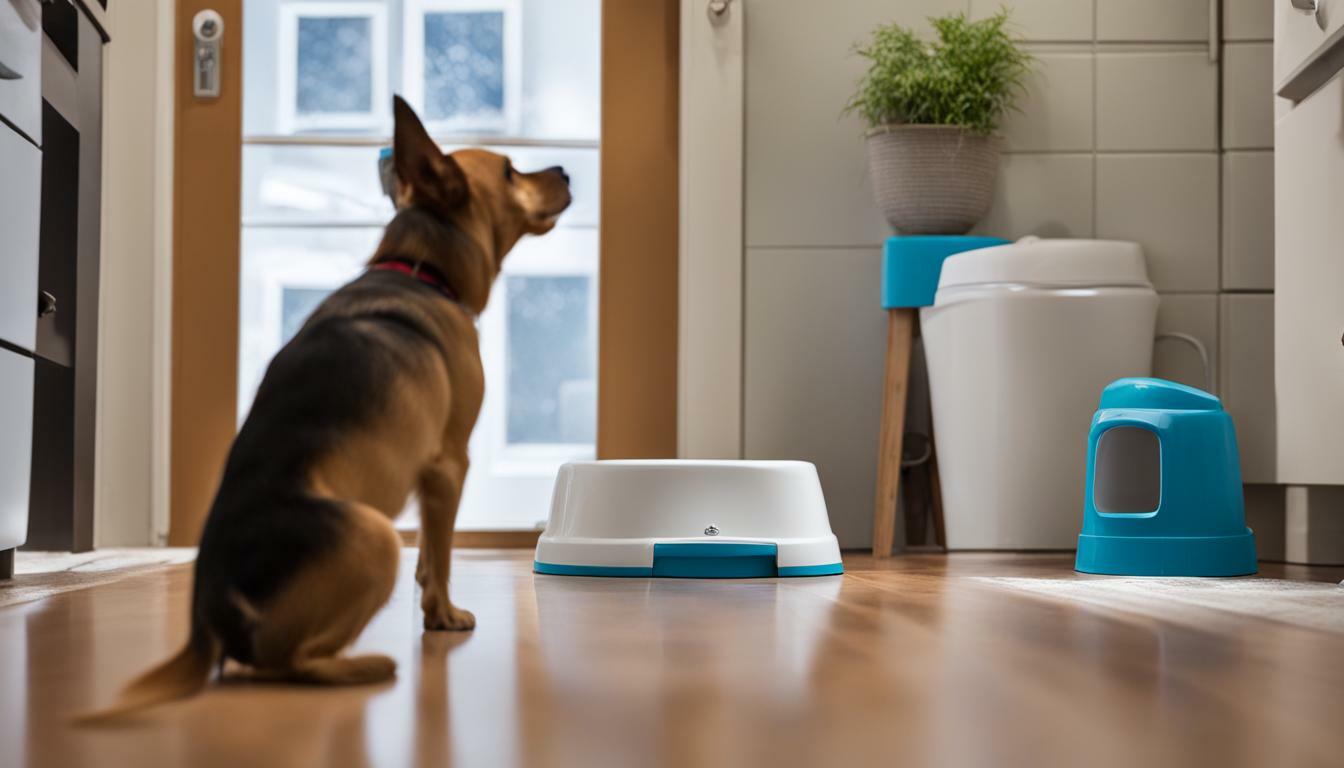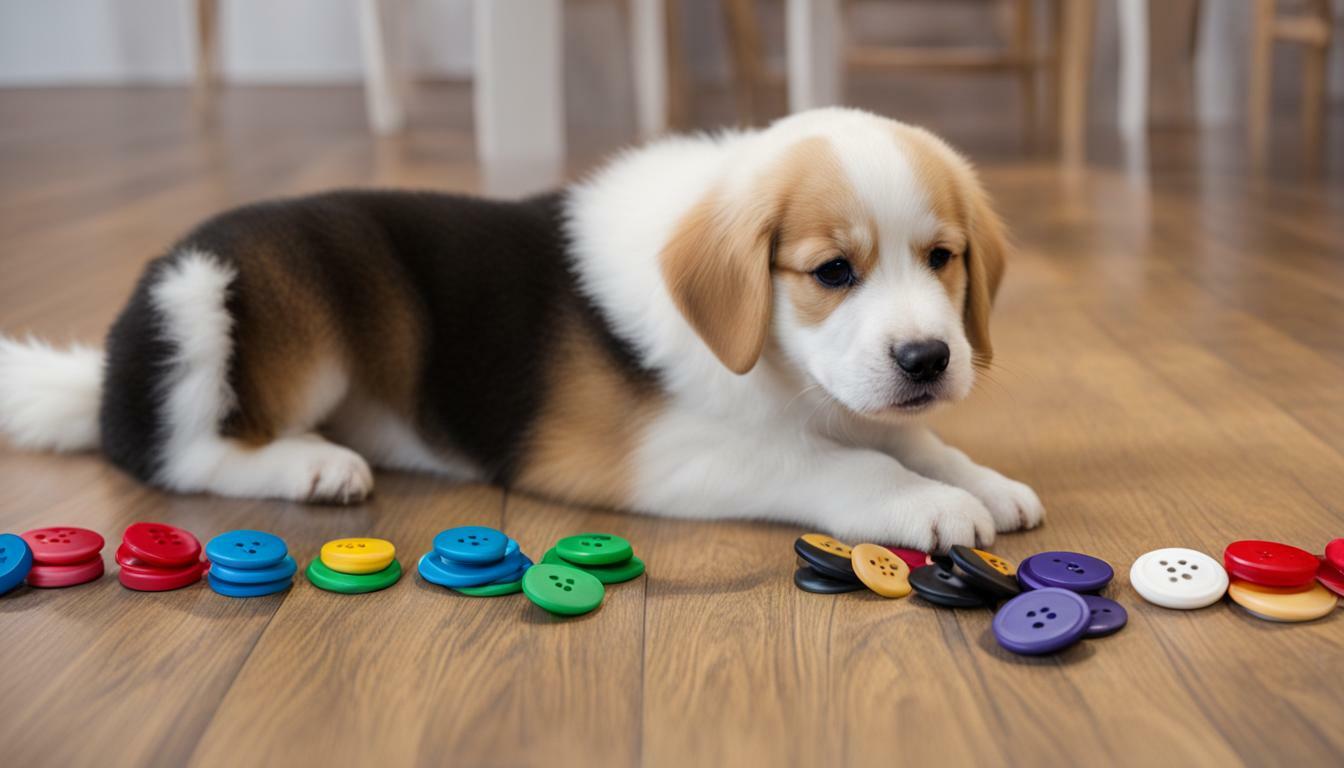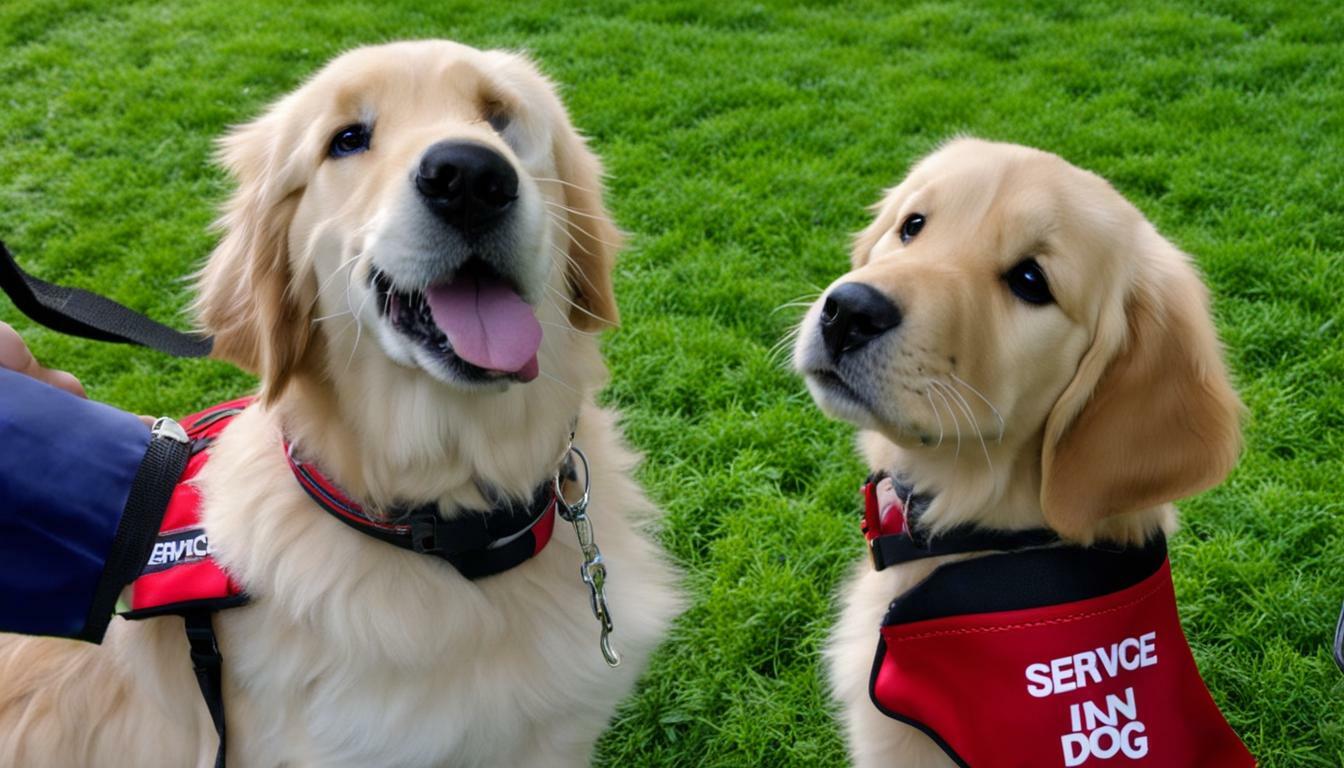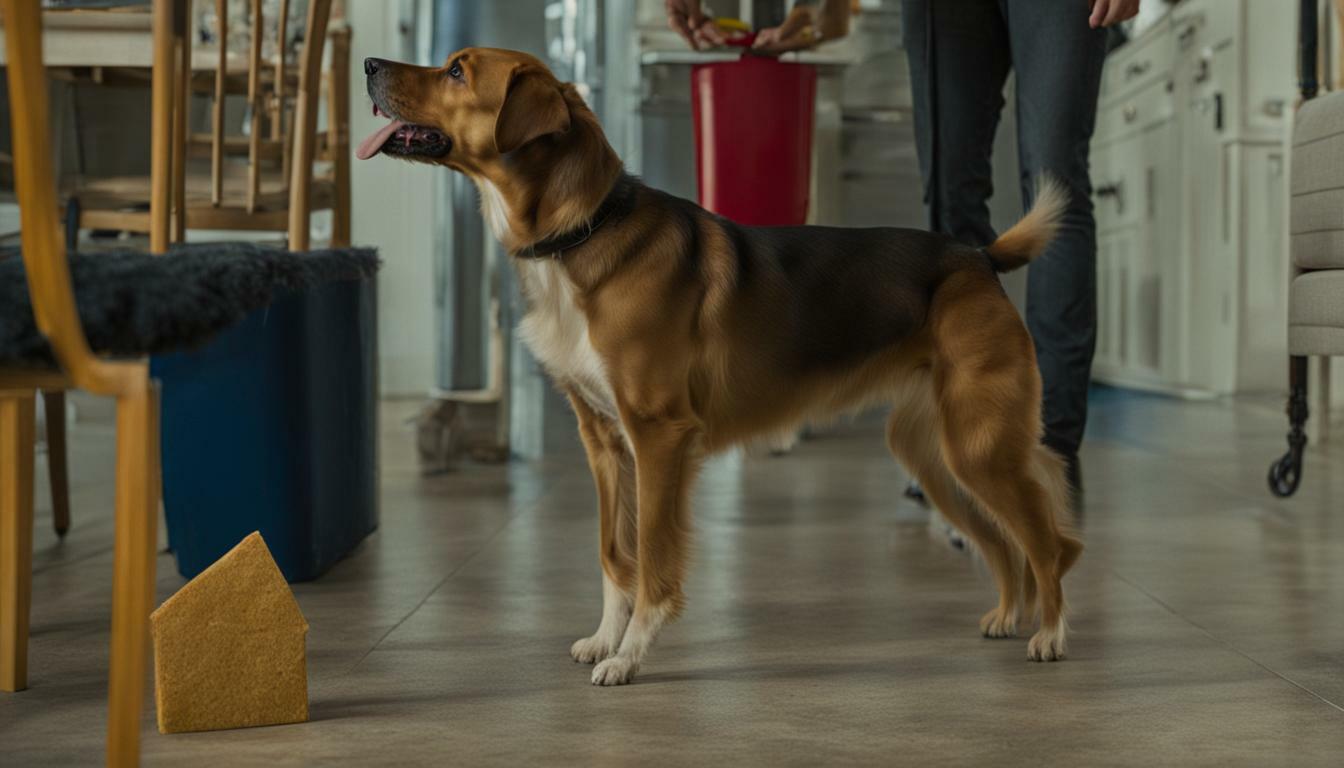Dogs are known for being loyal and loving companions, but they are also known for their bathroom habits. Many pet owners face the challenge of housebreaking their furry friends, especially those who live in apartments or have limited access to outdoor spaces. The thought of training dogs to use a litter box might seem unconventional, but it’s a solution worth exploring.
In this section, we will delve into the intriguing possibility of training dogs to use a litter box. We will explore the feasibility of this training method and provide practical tips and insights for a clean and hassle-free pet environment.
- Housebreaking a dog can be challenging, especially for those living in apartments or with limited outdoor access.
- Training dogs to use a litter box may seem unconventional but is worth exploring as a solution.
- In this section, we will explore the feasibility of litter box training and provide practical tips and insights for success.
Understanding the Benefits of Dog Litter Box Training
Training your dog to use a litter box can provide numerous benefits for both you and your furry friend.
- Housebreaking: Litter box training can be a helpful tool for housebreaking your dog, especially for puppies who may not have full control of their bladder and bowel movements yet.
- Convenience: Litter box training can offer a convenient solution, especially for those who live in apartments or have limited outdoor access. You won’t have to worry about rushing home to let your dog out for a bathroom break.
- Flexibility: Training your dog to use a litter box can give you more flexibility with your schedule and allow you to travel with your pet more easily.
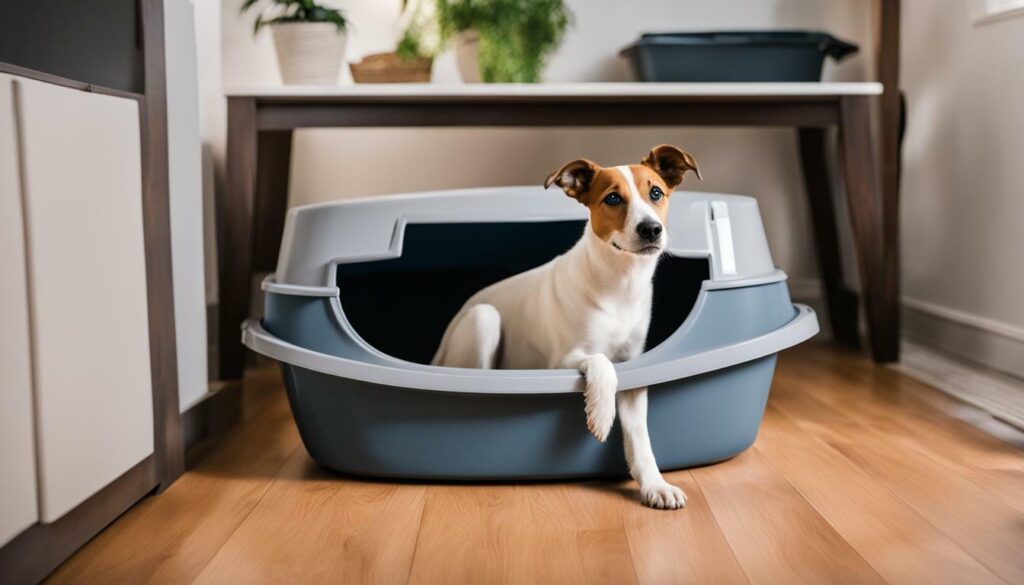
In addition, litter box training can be particularly beneficial for smaller dog breeds who may have difficulty accessing outdoor areas or for dogs with health conditions that make prolonged exposure to outdoor weather challenging.
Conclusion
When done properly, dog litter box training can provide a clean and convenient solution for managing your dog’s bathroom needs. By understanding the benefits of this training method, you can make an informed decision on whether it’s the right option for you and your pet.
Getting Started: The Basics of Litter Box Training for Dogs
Dogs can be trained to use a litter box, just like cats, but it requires patience, consistency, and positive reinforcement. The first step in training your dog to use a litter box is to choose a suitable spot in your home, away from food and water bowls and high traffic areas.
Once you have designated the litter box area, it’s time to introduce your dog to the box. Start by placing your dog on a leash and bringing them to the litter box. Encourage them to sniff and inspect the box. Use a verbal cue, such as “potty” or “go pee,” to help your dog associate the litter box with bathroom time.
It’s essential to keep a consistent routine when training your dog to use a litter box. Take your dog to the litter box at regular intervals, such as after meals, playtime, and naps. Praise and reward your dog with treats or verbal praise when they successfully use the litter box.
If your dog is hesitant to use the litter box, try placing a small piece of soiled paper or a small amount of their waste in the box to encourage them. Make sure to clean the litter box regularly, as dogs are sensitive to smells and may be deterred by a dirty litter box.
Remember, litter box training is not a one-size-fits-all solution for all dogs. Some dogs may prefer outdoor potty breaks or designated indoor areas. Patience, consistency, and positive reinforcement are key to successfully training your dog to use a litter box.
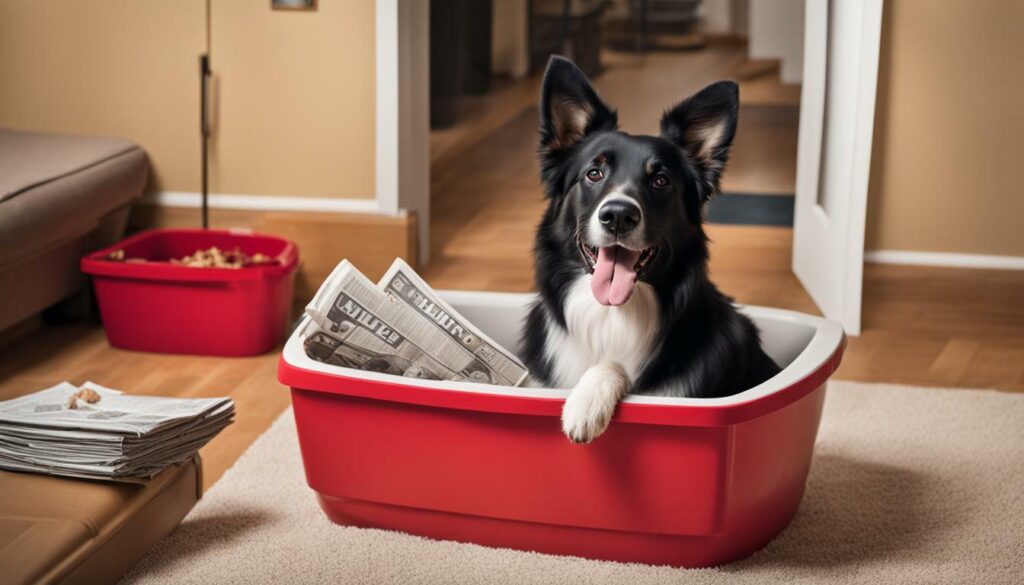
- Make sure the litter box is large enough for your dog to comfortably turn around and dig.
- Experiment with different types of litter to find the one that your dog prefers.
- Keep the litter box in a quiet, low-traffic area to minimize distractions and help your dog feel comfortable.
- Use a verbal cue consistently when taking your dog to the litter box, such as “go potty.”
- Never scold or punish your dog for accidents outside of the litter box, as this can deter them from using the litter box in the future.
Choosing the Right Litter Box for Your Dog
When selecting a litter box for your dog, it is important to consider their size, breed, and personal preferences. There are different types of litter boxes available, and each has its pros and cons.
The traditional litter box is rectangular in shape and is designed for small and medium-sized dogs. They are usually made of plastic and come in different colors and designs. These litter boxes are easy to clean and can be fitted with disposable liners for added convenience.
If you have a large dog, consider purchasing an extra-large litter box to provide more space for them to move around. Self-cleaning litter boxes may also be a good option for busy pet owners who want to minimize the frequency of litter box cleaning.
For dogs with mobility issues or senior dogs, consider purchasing a litter box with lower sides for ease of access. Covered litter boxes can provide privacy for dogs who prefer it, but they may also trap odors and make cleaning more challenging.
Remember to choose a litter box that is appropriate for your dog’s size and needs for optimal comfort and training success.
| Litter Box Type | Pros | Cons |
|---|---|---|
| Traditional Litter Box | Easy to clean, disposable liners available, various colors and designs | Not suitable for large dogs, may require frequent cleaning |
| Extra-Large Litter Box | Provides more space for large dogs to move around | May take up more room, can be difficult to move and clean |
| Self-Cleaning Litter Box | Reduced frequency of litter box cleaning, convenient for busy pet owners | More expensive, may require electricity or batteries, not suitable for all dogs |
| Low-Sided Litter Box | Easier access for senior dogs or those with mobility issues | May not contain litter as effectively, may not be suitable for larger dogs |
| Covered Litter Box | Provides privacy for dogs who prefer it, may trap odors | Can be more difficult to clean, may not be suitable for all dogs |

When it comes to litter box training for dogs, choosing the right type of litter is crucial for success. Different types of litter have varying levels of comfort, absorbency, and odor control, so it’s important to consider your dog’s preferences and needs.
Here are some factors to consider when selecting the right litter for your dog:
| Litter Type | Description |
|---|---|
| Clay | Clay litter is the most popular option and widely available. It is absorbent and has good odor control, but it can be dusty and heavy. Some dogs may not like the texture. |
| Plant-Based | Litters made from materials like paper, wood, or corn are becoming more popular. They are usually lightweight, eco-friendly, and have good absorbency. However, some may not mask odors as well as clay litter. |
| Grass | Grass litter is made from hydroponic grass and is a newer option for dogs. It is absorbent, lightweight, and eco-friendly, but it can be expensive and may not be as readily available as other types of litter. |
Ultimately, the best litter for your dog is one that they feel comfortable using. Some dogs may have a preference for a certain texture or scent, so it may take some trial and error to find the right fit.
Pro tip: If you have multiple litter boxes or dogs in your household, consider using different types of litter in each box to accommodate individual preferences.
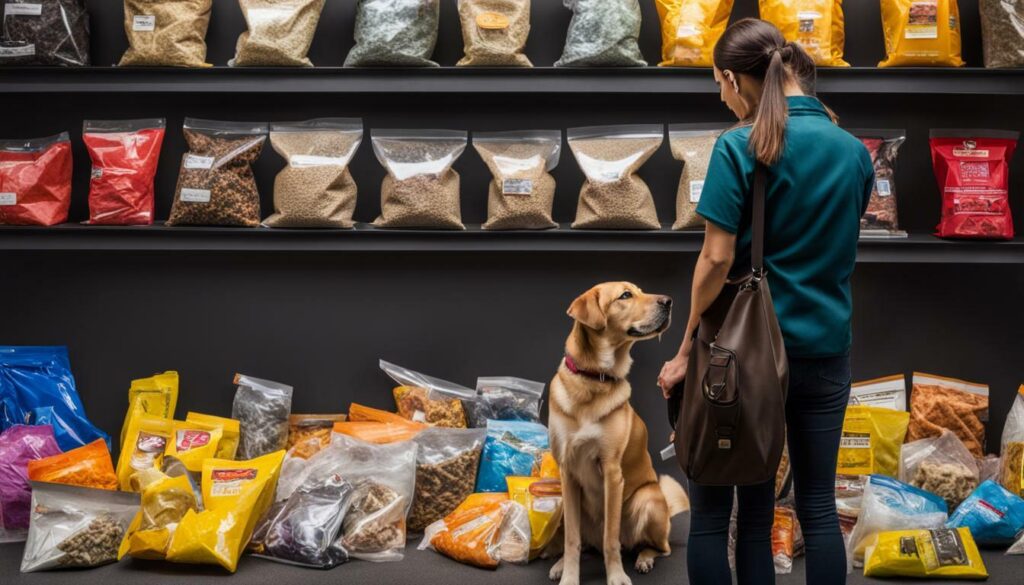
Keep in mind that some types of litter may not be suitable for certain dogs, particularly those with respiratory issues or who are prone to eating non-food items. Always consult with your veterinarian before making any changes to your dog’s litter or environment.
Overall, choosing the right litter is an important step in ensuring successful litter box training for your dog. Take the time to consider your dog’s needs and preferences, and don’t be afraid to try different options until you find the perfect fit.
Introducing Your Dog to the Litter Box
Introducing your dog to the litter box is a crucial step in the training process. It is essential to create a positive and comfortable environment to encourage your dog to use the litter box consistently.
The first step is to select the right location for the litter box. Choose a spot in your house that is easily accessible for your dog and away from their sleeping and eating areas.
Once you have chosen the location, it’s time to introduce your dog to the litter box. Start by placing the litter box in the selected area and let your dog sniff around it. Encourage your dog to investigate the litter box and reward them with positive reinforcement, such as treats or praise, when they show interest.
At first, your dog may be hesitant to use the litter box. Be patient and avoid forcing them into it. Instead, try placing your dog in the litter box or leading them towards it with a treat. Remember to use positive reinforcement to encourage good behavior.
As your dog becomes more comfortable with the litter box, gradually increase their exposure to it. Start by placing your dog in the litter box after meals or naps. Gradually extend the time spent in the litter box until your dog is comfortable using it for extended periods.
If your dog shows reluctance to use the litter box, try changing the litter or litter box type. Some dogs may prefer a specific texture or scent, and a change in litter type may encourage them to use the box.
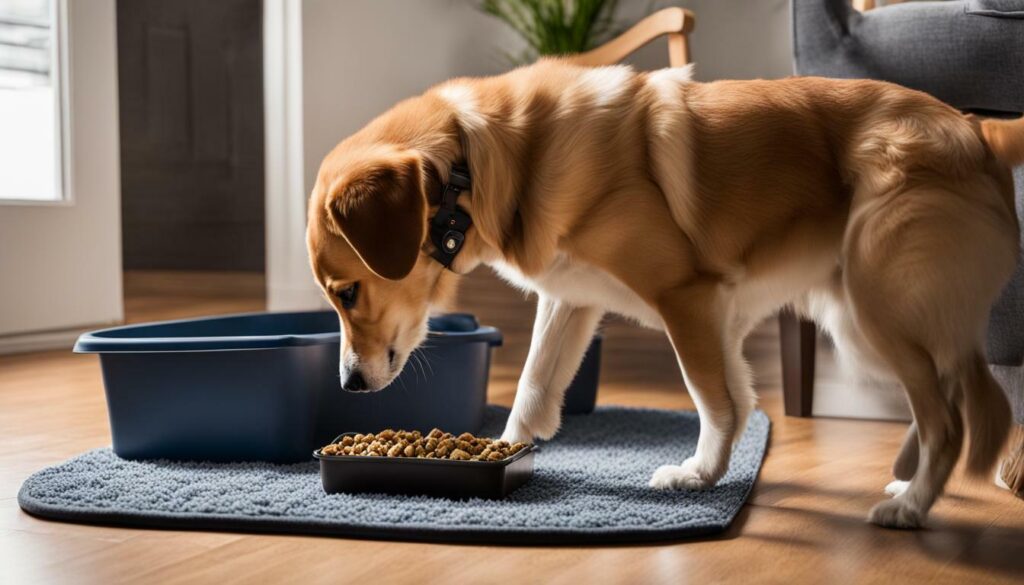
Remember to emphasize positive reinforcement throughout the introduction process. Reward your dog for good behavior and avoid punishing them for accidents outside the litter box. With patience and consistency, your dog will learn to use the litter box in no time.
Establishing a Routine and Reinforcing Good Behavior
Establishing a routine is crucial for successful litter box training. Dogs thrive on structure and consistency, and having a regular schedule for feeding and bathroom breaks can help with their training progress.
Set a routine for your dog’s meals and stick to it as closely as possible. The same applies to bathroom breaks – take your dog to the litter box at regular intervals throughout the day. Consistency is key to reinforcing good behavior and preventing accidents outside the box.
Positive reinforcement is also important in litter box training. Whenever your dog successfully uses the litter box, reward them with praise or a treat. This will help them associate the litter box with positive experiences and increase the likelihood of them using it again in the future.
It’s essential to remain patient and consistent during the training process. Some dogs may take longer than others to get the hang of litter box training, so it’s important to stay positive and celebrate every success along the way.
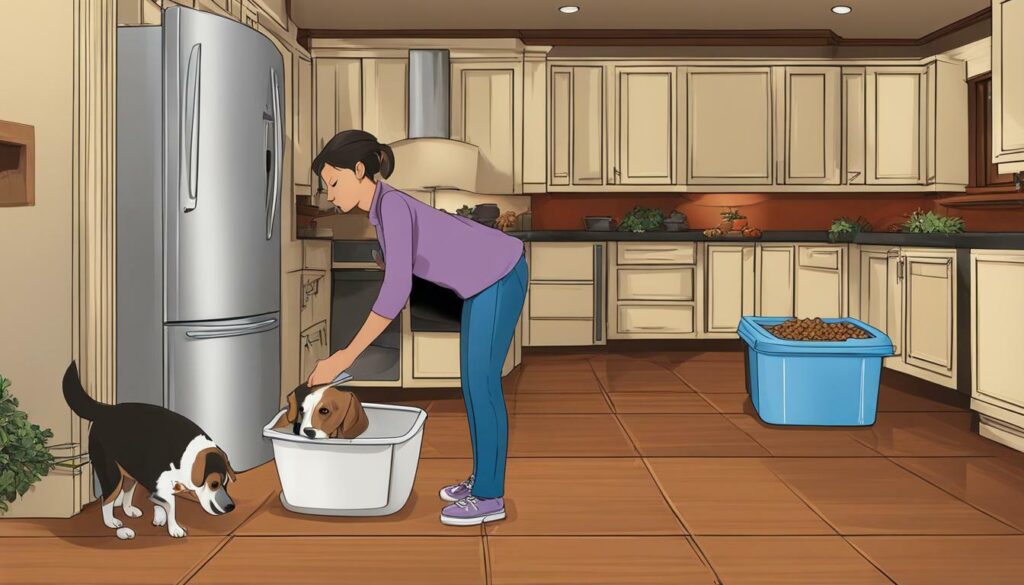
| Do: |
|
|---|---|
| Don’t: |
|
Troubleshooting Common Challenges in Litter Box Training
While litter box training can be a feasible and convenient method for managing your dog’s bathroom needs, it is not without its challenges. Here are some common issues and solutions to help troubleshoot your dog’s litter box training progress.
| Challenge | Solution |
|---|---|
| Accidents outside the litter box | If your dog is having accidents outside the litter box, re-evaluate the location and cleanliness of the box. Ensure it is easily accessible for your dog and clean it regularly. If your dog continues to have accidents despite these measures, consider confining them to a smaller space or seeking professional help. |
| Reluctance to use the litter box | If your dog is hesitant to use the litter box, try enticing them with treats and positive reinforcement. Gradually acclimate your dog to the litter box by placing them near it and rewarding them for sniffing or approaching it. If your dog still refuses to use the box, try a different litter type or seek professional help. |
| Regression in training progress | It is normal for dogs to have setbacks in their litter box training progress. If your dog regresses in their behavior, review your training techniques and continue to reinforce positive litter box behavior. Consider reducing your dog’s access to other areas of the house until they consistently use the litter box. |
Remember, patience and consistency are crucial to successful litter box training. Don’t hesitate to seek professional help if you are experiencing persistent challenges or behavioral issues with your dog.

Training dogs for litter box use is possible at any age, but the techniques and expectations may differ depending on whether you are training an adult dog or a puppy. While puppies are often more adaptable and easier to train in new habits, adult dogs may take longer to unlearn old habits and adjust to new ones.
When training puppies, start as early as possible, ideally around eight weeks of age. Puppies have a natural instinct to keep their den (living space) clean, which can make litter box training easier. Begin by placing the litter box near the puppy’s sleeping area and gradually move it towards the desired location.
On the other hand, training adult dogs may require more patience and persistence. Start by observing your dog’s bathroom habits and identifying a consistent time and location for using the litter box. Avoid punishing or scolding your dog for accidents outside the box, as this can create anxiety and confusion. Instead, focus on positive reinforcement and reward good behavior with praise and treats.
Overall, both puppies and adult dogs can be successfully trained to use a litter box with the right techniques and consistent reinforcement. However, it is important to keep in mind your dog’s individual needs and temperament and adjust the training accordingly.

If you’re looking to maximize your success in training your dog to use a litter box, consider incorporating these tips into your routine:
- Stick to a consistent feeding and bathroom schedule: A routine will help your dog associate specific times with using the litter box. Stick to a regular schedule, and avoid free-feeding or free-rein bathroom time.
- Use positive reinforcement: Praise and reward your dog when they use the litter box correctly. Avoid scolding or punishment for accidents.
- Gradually increase the time between bathroom breaks: As your dog becomes more comfortable using the litter box, gradually increase the time between bathroom breaks, but be sure to monitor for any signs of regression.
- Make adjustments as needed: If you notice any issues or setbacks, such as accidents outside the litter box, consider adjusting the litter type, box location, or training method.
- Be patient and consistent: Litter box training can take time, so be patient and consistent with your training. Avoid giving up too soon or becoming discouraged by setbacks.
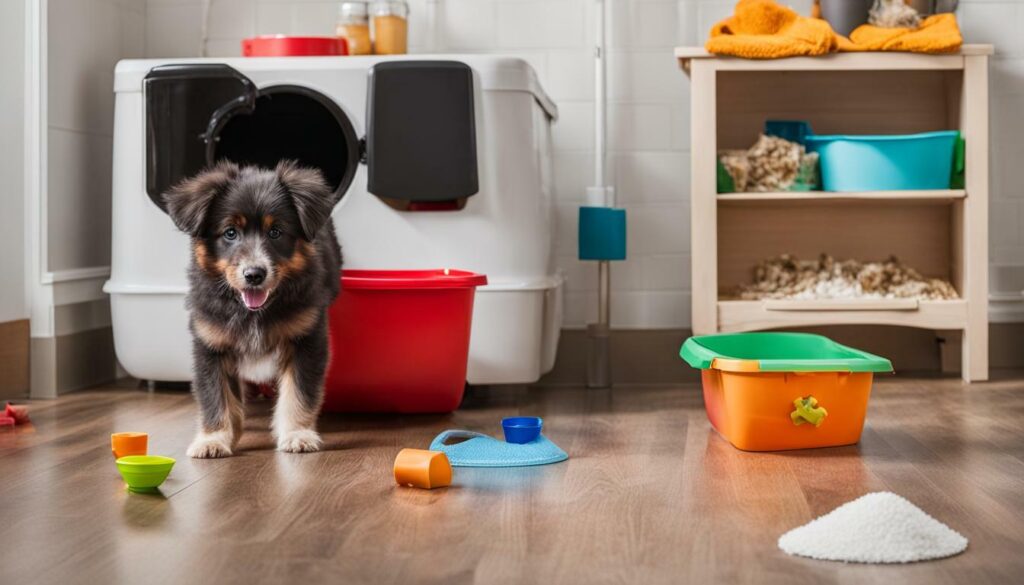
By following these tips and techniques, you can increase your odds of success in training your dog to use a litter box. Remember that every dog is different, so don’t be afraid to adapt your training to suit your pet’s individual needs.
Alternatives to Litter Box Training for Dogs
If litter box training is not feasible or suitable for your dog, don’t fret – there are alternative options available.
Indoor Potty Pads: One option is the use of indoor potty pads, which are similar to disposable diapers for dogs. These pads provide a designated space for dogs to relieve themselves, and can be disposed of after use. However, it is important to note that some dogs may confuse these pads with other absorbent surfaces in the house, such as carpets or towels, which can lead to accidents.
Outdoor Designated Areas: If you have access to an outdoor space, you can create a designated area for your dog to relieve themselves. This can be achieved by fencing off a small section of your yard or using a specific patch of grass. Alternatively, you can take your dog for frequent walks to provide ample opportunities for them to go outside.
Bell Training: Another technique is bell training, which involves teaching your dog to ring a bell to signal that they need to go outside. This method can be effective for dogs who struggle with communicating their need to go outside and can also help prevent accidents indoors.
Remember, each dog is unique, and what works for one may not work for another. It may take some trial and error to find the best solution for your individual dog.
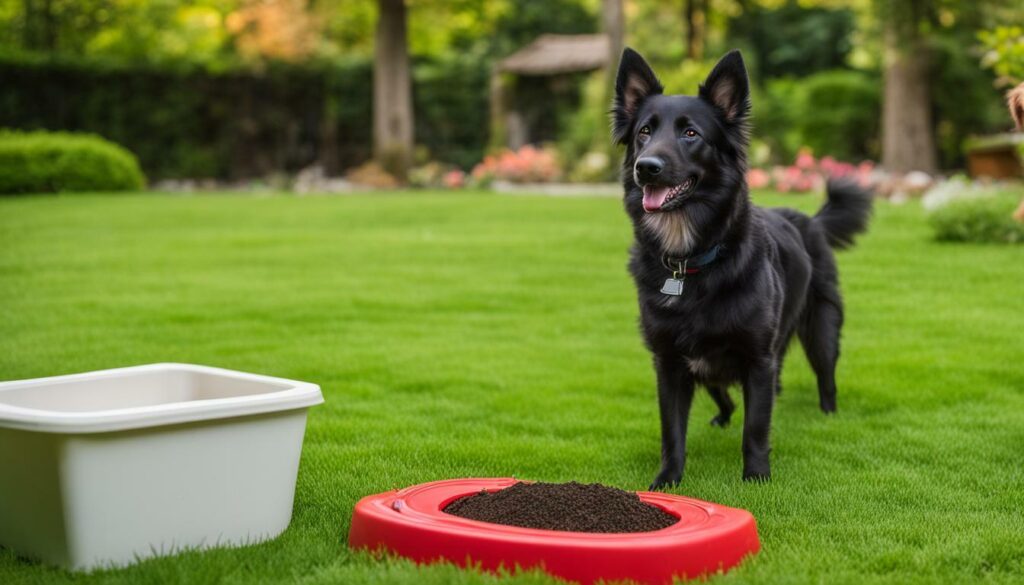
When to Seek Professional Help for Litter Box Training
While litter box training can be a straightforward process, there may be instances where seeking professional help is necessary. If your dog is experiencing significant difficulty adapting to the litter box or is exhibiting persistent behavioral issues, it may be time to consult a professional dog trainer or behaviorist.
Some signs that your dog may require professional assistance include:
- Continual accidents outside the litter box
- Refusal to use the litter box after multiple attempts at training
- Aggression or fearfulness when approaching the litter box
- Excessive scratching or digging around the litter box area
A trained professional can assess your dog’s behavior and provide targeted advice and techniques to address any underlying issues. They may also be able to offer guidance on alternative training methods or solutions if litter box training is not feasible for your dog’s individual needs.

Remember, patience and consistency are key when training your dog to use a litter box. With dedication and the right approach, most dogs can be successfully trained to use a litter box. However, if you are encountering significant challenges or concerns, don’t hesitate to seek professional help for the benefit of both you and your furry friend.
Section 13: Maintaining Successful Litter Box Training in the Long Run
Once your dog has successfully learned to use a litter box, it’s crucial to maintain the training to ensure long-term success. By following a few tips and techniques, you can create a consistent routine that promotes continued litter box usage and reduces the risk of accidents outside the box.
Establish a Regular Cleaning Schedule
Maintaining cleanliness is key to keeping your dog motivated to use the litter box. You should aim to clean the box at least once a day, removing any solid waste and topping up the litter if necessary. Once a week, dispose of all litter and thoroughly clean the box with soap and water. By establishing a regular cleaning schedule, you can reduce the risk of odor buildup and promote a hygienic environment that encourages your dog to use the box.
Reinforce Positive Behavior
Positive reinforcement is crucial to maintaining ongoing success with litter box training. Whenever your dog uses the box correctly, offer verbal praise, treats, or toys as a reward. This reinforces the desired behavior and creates a positive association with the litter box. It’s especially important to continue positive reinforcement during the early stages of training to promote consistency and habit formation.
Monitor Your Dog’s Progress
Even after your dog has successfully been litter box trained, it’s important to monitor their progress and adjust the training as necessary. If you notice your dog having frequent accidents outside the box, it may indicate a need for additional training or a different type of litter. Be observant of your dog’s behavior and make adjustments as needed to maintain their success with litter box usage.
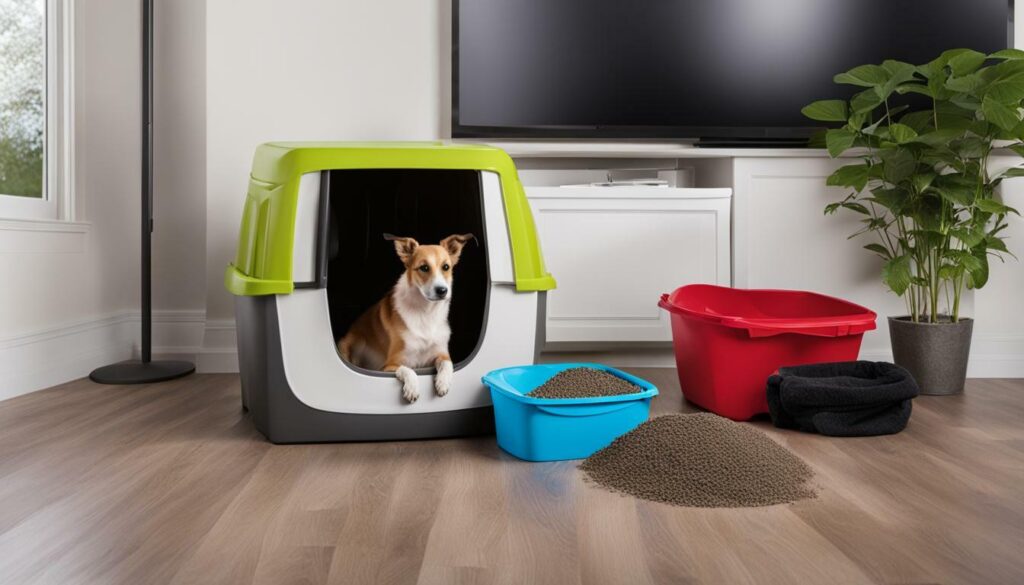
Address Any Setbacks Promptly
Even the best-trained dogs may experience setbacks, such as illness or changes in routine, that disrupt their litter box usage. When this occurs, it’s important to identify and address the issue promptly to prevent further regression in training progress. Consider revisiting foundational training techniques, such as positive reinforcement and gradual acclimation to the litter box environment, to help your dog regain their confidence and success with litter box usage.
Conclusion
Maintaining successful litter box training requires ongoing diligence and consistency. With the right approach, however, it’s possible to create a hygienic and convenient pet environment that benefits both you and your dog. By following the tips and techniques outlined in this article, you can help your dog maintain their success with litter box usage for years to come.
Conclusion: Achieving a Clean and Convenient Pet Environment
Training dogs to use a litter box is a feasible option for pet owners looking for a cleaner and more convenient indoor solution for their dogs’ bathroom needs. By following the fundamental steps and techniques outlined in this article, pet owners can successfully train their dogs to use a litter box with patience, dedication, and consistency.
One of the significant benefits of litter box training for dogs is the convenience it provides to pet owners. It eliminates the need for frequent outdoor walks and allows for more flexibility in scheduling. It is especially beneficial for dogs living in apartments or areas with limited outdoor access.
Furthermore, litter box training can help with housebreaking and reduce the chance of accidents and messes around the house. By establishing a consistent routine and positive reinforcement techniques, pet owners can ensure that their dogs learn to use the litter box effectively.
Choosing the appropriate litter box and litter type is crucial for a successful training outcome. Pet owners should consider their dog’s size, breed, and preferences when selecting a litter box. Similarly, the choice of litter can also impact the dog’s comfort level and training success.
Like any training method, litter box training may come with common challenges, such as accidents outside the box or reluctance to use it. However, troubleshooting and maintaining consistency can overcome these challenges in the long run.
It is essential to note that litter box training may not be suitable for every dog, especially those with underlying behavioral or health issues. In such cases, seeking professional help is necessary to ensure the dog’s well-being and successful training outcome.
In conclusion, litter box training for dogs can provide a cleaner and more convenient pet environment for pet owners while offering housebreaking benefits to dogs. With proper training techniques, choosing the right litter box and litter type, and ongoing maintenance and reinforcement, pet owners can ensure a successful training outcome and a happy and healthy dog.
FAQ
Can dogs be trained to use a litter box?
Yes, it is possible to train dogs to use a litter box. In this section, we will explore the feasibility of this training method and provide practical tips for a clean and hassle-free pet environment.
What are the benefits of dog litter box training?
Training dogs to use a litter box offers several benefits. It can aid in housebreaking, provide convenience for pet owners, and offer an alternative for dogs living in apartments or with limited outdoor access.
How do I get started with litter box training for my dog?
To start training your dog to use a litter box, consistency, positive reinforcement, and creating the right environment are crucial. In this section, we will cover the fundamental steps and techniques involved in litter box training.
How do I choose the right litter box for my dog?
Selecting the appropriate litter box for your dog’s size, breed, and preferences is essential. We will provide guidance on different types of litter boxes available in the market and discuss their pros and cons.
What type of litter should I use for my dog’s litter box?
Choosing the right litter for your dog’s needs is important for successful training. We will discuss different options such as clay, paper, and grass litter, and offer insights on which may work best for your dog’s comfort and training success.
How do I introduce my dog to the litter box?
Introducing your dog to the litter box requires gradual acclimation and positive reinforcement techniques. We will provide step-by-step instructions and troubleshoot common challenges during the initial stages of litter box training.
How can I establish a routine and reinforce good litter box behavior?
Establishing a consistent routine for your dog’s litter box training is crucial. We will provide tips on setting feeding and bathroom schedules and methods for reinforcing positive litter box behavior.
What should I do if I encounter challenges during litter box training?
Common challenges such as accidents outside the box or reluctance to use it can arise during the training process. We will offer solutions and troubleshooting tips to help overcome these obstacles.
Can I train adult dogs and puppies to use a litter box?
Litter box training techniques may vary depending on the age of your dog. We will discuss the differences and considerations when training adult dogs compared to puppies and provide specific techniques for each stage of life.
Do you have any additional tips for successful litter box training?
In addition to the fundamental steps, we will provide extra tips and techniques to enhance the success of your dog’s litter box training. Topics covered include maintaining cleanliness, preventing accidents, and adapting the training to your dog’s individual needs.
Are there alternatives to litter box training for dogs?
If litter box training is not feasible or suitable for your dog, there are alternative options available. We will explore the use of indoor potty pads, outdoor designated areas, and other potential solutions.
When should I seek professional help for litter box training?
If you encounter persistent challenges or behavioral concerns during litter box training, it may be necessary to seek professional assistance. We will discuss signs of underlying issues and when it is appropriate to consult an expert.
How can I maintain successful litter box training in the long run?
Ongoing maintenance and reinforcement are crucial for long-term success in litter box training. We will discuss the importance of troubleshooting setbacks and adapting the training as your dog grows and develops.
What are the benefits of achieving a clean and convenient pet environment?
In conclusion, training dogs to use a litter box can lead to a cleaner and more convenient pet environment. We encourage pet owners to explore this training method with patience and dedication.
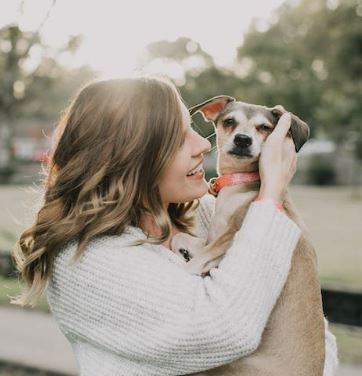
Marissa Delotta, 36, from Dayton, Ohio, is the creative force behind Roverboard.com, a beloved online destination for dog lovers. As a dedicated mom and canine enthusiast, Marissa combines her family experiences with her love for dogs to offer a platform where dog owners can exchange tips, heartwarming stories, and advice. Her website has become a vibrant community for sharing the joys of dog parenting. In her free time, Marissa enjoys exploring dog parks with her family and volunteering at local animal shelters.

